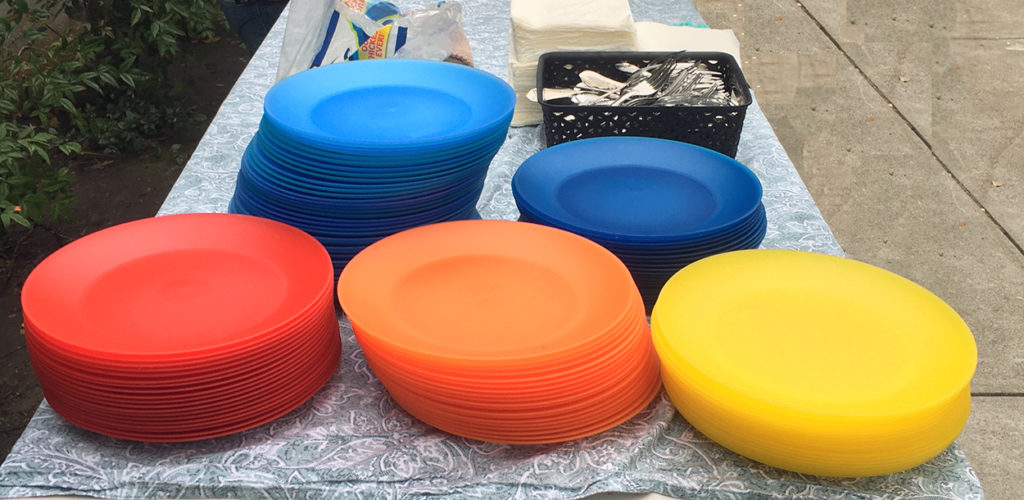The waste-free desires of even the most well-intentioned party planner can be thwarted because few people simply don’t have enough dishes for more than a handful of guests. And even if you did have 50 plates, where would you store them?
One solution growing in popularity as part of both the sharing economy and zero-waste movements is the Zero Waste Party Pack. The concept is simple: create one all-purpose kit of serving supplies, utensils, and even décor that can be borrowed and reused in a neighborhood or community group.
The concept was popularized in places like Palo Alto, California, where the city launched the Zero Waste Party Pack initiative in 2012. The city distributed 22 party packs throughout the city, which were hosted by volunteer Zero Waste Block Leaders. Any resident of Palo Alto can checkout a party pack by contacting a nearby block leader through the city’s website.
In Narberth, PA, a suburb of Philadelphia, the town’s Civic Association hosts its own shareable kit to promote sustainability. At the organization’s events, guests use the collection of cloth napkins and real silverware, and association members have dining reusables available for loan (one has 50+ cloth napkins, another member has a 150-piece utensil set, another has a large set of plates, another with tablecloths, etc.). The board is moving toward a more formal “lending library” process to encourage more residents and organizations to ditch the disposables and use shared materials for events.
In Washington D.C., one nonprofit will even bring the kit directly to you and pick it up for cleaning! GreenThinker DC will drop off enough supplies for 50 people within the District of Columbia plus a 20-mile radius. Founded in 2019 to promote low-waste living, GreenThinker DC is also building a library of party décor through donations.
Philadelphia resident Tanya Seaman started her own zero-waste kit in 2010 when she was organizing a board retreat for a local neighborhood organization. To avoid disposable waste, she bought three sets of utensils and 36 dinner plates. She has gone on to lend the items for several neighborhood occasions, including pot lucks and block parties.
“When I am invited to a party and the host mentions they want to make it as zero-waste as possible, I offer to bring them,” Tanya says. “Even if people don’t specify an interest, I still make the offer!”
Why create a zero-waste party pack?
Single-use plastics in landfills can leak harmful pollutants into the watershed and plastics on the tops of landfills can be carried away by the wind. A full 32 percent of the 78 million tons of plastic packaging produced annually is left to flow into our oceans, the equivalent of pouring one garbage truck of plastic into the ocean every minute. Even if they remain in the landfills, just one ubiquitous Red Solo Cup could take 450 years to decompose!
In addition to reducing disposable waste, you can help your community save money on party and event planning.
How to set up a zero-waste party pack for your community:
What is in a zero-waste party pack?
Stackable, durable dishes and plates are ideal. Depending on your bandwidth, you could create a pack to serve anywhere from 20-200 people! Fifty is a general guideline for shareable use. Forks, spoons and knives don’t need to match — nor do the dishes if you want to have a shabby chic aesthetic. A few tablecloths and a set of cloth napkins in dark colors are best for avoiding stains. Leftover banners and other decorative décor can be a fun and welcome addition to your party kit — after all, a “Congratulations” or “Happy Birthday” sign has infinite uses!
How do you pay for it?
You may not even have to! It’s likely that you and your like-minded friends and neighbors can put a party pack together by pooling your resources. Those dishes passed down from grandma in the box, the extra cutlery from takeout (if you want to reuse plastic), the tablecloths you purchased for that one party — you may have the pieces to get started already at your fingertips. If you need to purchase additional items, you could be the generous donor, ask your friends and neighbors to go in on the set or reach out to a green-minded department of your local government or civic association for assistance.
How does it work?
The party pack can be hosted by a generous individual or through a community organization gathering space like a recreation center. In most cases, folks borrow the box, wash the dishes and fabrics, and return them when they are done.
How do you promote the service?
If you are interested in being the party pack host, you’ll need a way to let others know it is available. Options for sharing include community civic associations, church bulletin boards, and local Buy Nothing or Zero Waste community groups on Facebook or other social media. You can also reach out to like-minded organizations — like your city or township’s department of sustainability — to let them know about your plans and see if they would like to partner, host, or promote!
##
This post is part of our Winter 2019 editorial series on waste reduction. Get our free ebook on this series: “Beyond Waste: Community Solutions to Managing Our Resources.” Shareable is a partner of this project with Greenpeace.
Take a look at the other articles in the series:
- Celebrate the radical power of DIY during MAKE SMTHNG Week
- Communities worldwide prepare to host MAKE SMTHNG Week events
- Fashion Detox Challenge invites people to pause, reflect and change
- How the MyMizu app is creating community and fostering sustainability in Japan
- Right to Repair movement invites us to review the way we produce and consume electronics
- From Oakland to Utrecht, sustainability-focused maker villages unite artisans for creative exchange
- Using ancient values to solve modern problems at the Eunpyeong Sharing Center
- Community cupboards feed neighborhoods despite legal hurdles









